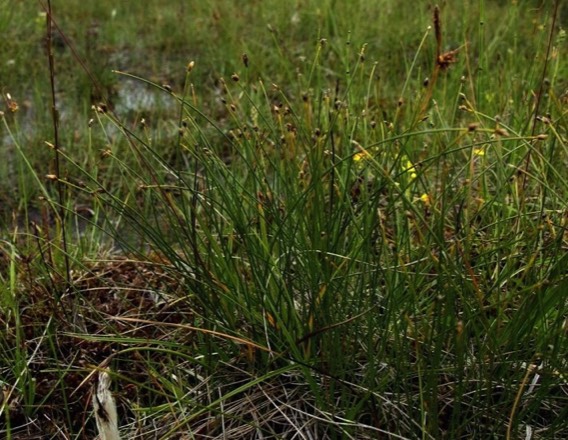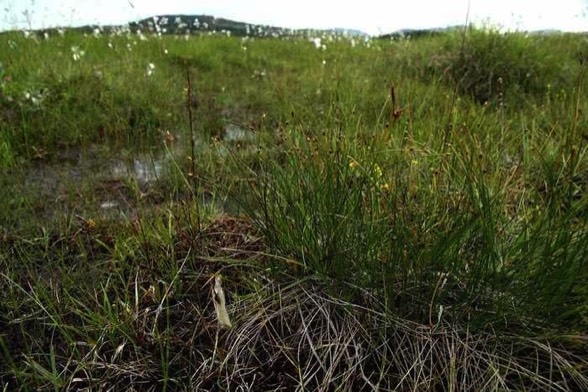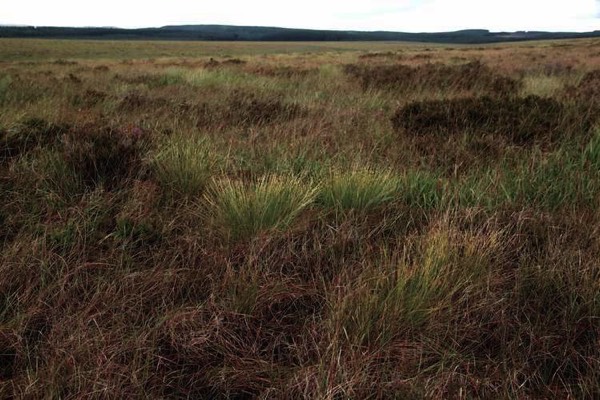SUMMARY ~
Trichophorum cespitosum
Northern Deergrass
Click one of the buttons below [wider screens only] for short summary accounts.
For the detailed pages, select from the drop-down menu in the top banner under 'Deergrasses', or from the sidebar [on narrow screens, it’s a bottom-bar!], or see the box of links at the base of the window [if visible].
Enter the name for this tabbed section: General

Larger (and probably very old) plants on acid mires can be tall and dense with straight (but still distinctly slender) stems. See photos in ‘Habitats’ tabs.
Beware stunted plants of Common Deergrass! the strongly oblique upper-leaf-sheath openings of the latter will at once separate.
It is most obviously distinct from Common Deergrass when growing in mineral-rich seepage mires – often with relict species such as Bartsia alpina and Tofieldia pusilla – where Common Deegrass is typically absent. In dense and diverse vegetation of such mires it can be quite inconspicuous and easy to overlook!
It is a particularly delightful find when fruiting vigorously in such mires, the tiny clusters of a few black-looking nuts almost invisible against 'busy' background vegetation, but appearing to the eye when a cluster of stems is cupped in the hand, or white paper is placed behind the tuft.
It is often far more abundant on undisturbed ombrogenous (i.e. rain-fed) deep mires in Northern England, Scotland and Ireland (see the ‘Habitats’ button above, and the ⇒Habitats page, and references, ⇒Sources/reading page).
The ⇒Distributions map indicates its apparent rarity: some dots in southern areas may not correctly refer to this species, and (from Andy Amphlett's work in Speyside) it may well still be largely overlooked in other parts of Scotland.
See also the ⇒hybrid page and especially the ⇒Identification pages for more detailed information.
Enter the name for this tabbed section: ID
See the dedicated pages, ⇒Field identification ~ 1 and ⇒~ 2 for much more detailed information.
You can download a simple chart for *field identification* as a two-page A5 ⇓PDF (114 KB; opens in a new window).
Although externally similar, the two deergrass species are very distinct in their internal morphology, and readily separable: these are two good species!
The two species can be confirmed when fruiting from their uppermost leaf-sheath openings, and with a high degree of confidence by examination of their ⇒stem cross-sections.
The ⇒Hybrid Deergrass can often be found where Northern Deergrass is absent (or if present, is very inconspicuous and elusive), and varies in stature so that it can appear very similar – indeed bridging the gap between the species and confusing the picture.
In the early part of the growing season, mixed populations can be tricky to separate in the field. Length of sheath-opening provides the best guide at this stage.
Back home, stem-sections of soft young emergent stems can be awkward to prepare and may be ambiguous until tissues mature.
Always remember that the hybrid is sterile and through July drops its aborted flowers and glumes and so eventually appears almost completely 'bare-headed'.
So the three taxa are much easier to separate from July onwards until dieback in September.
Note that the two species often fail to ripen fruit in some seasons, but then their spikes often retain the glumes, appearing distinctively bleached and pale in the late season, and thus different from the bare-headed hybrid.
You can download a simple chart for *field identification* as a two-page A5 ⇓PDF (114 KB; opens in a new window).
Although externally similar, the two deergrass species are very distinct in their internal morphology, and readily separable: these are two good species!
The two species can be confirmed when fruiting from their uppermost leaf-sheath openings, and with a high degree of confidence by examination of their ⇒stem cross-sections.
The ⇒Hybrid Deergrass can often be found where Northern Deergrass is absent (or if present, is very inconspicuous and elusive), and varies in stature so that it can appear very similar – indeed bridging the gap between the species and confusing the picture.
In the early part of the growing season, mixed populations can be tricky to separate in the field. Length of sheath-opening provides the best guide at this stage.
Back home, stem-sections of soft young emergent stems can be awkward to prepare and may be ambiguous until tissues mature.
Always remember that the hybrid is sterile and through July drops its aborted flowers and glumes and so eventually appears almost completely 'bare-headed'.
So the three taxa are much easier to separate from July onwards until dieback in September.
Note that the two species often fail to ripen fruit in some seasons, but then their spikes often retain the glumes, appearing distinctively bleached and pale in the late season, and thus different from the bare-headed hybrid.
Enter the name for this tabbed section: Habitats

Distinctively, it occurs in +/- calcareous seepage mires (right), sometimes with relict species such as Bartsia alpina and Tofieldia pusilla, or local species such as Eriophorum latifolium and Carex capillaris - habitats where Common Deegrass is absent.
It also occurs in the 'lagg-zone' of basin- and valley-mires - i.e where there is seepage of soligenous waters into the mire from the surroundings, but can occur most frequently in deep-peat mires of raised- and valley-mires.

The differences in habitat between these two types – mineral-rich and mineral-poor – is so striking that there may be different ecotypes involved. No morphological differences have yet been detected.
More work needs to be carried out to establish the limits of the hybrid's tolerances versus this species in UK. In damper mire habitats, the hybrid is also likely to occur, usually greatly outnumbering either species.
(See Andy Amplett's very clear note (BSBI News, No. 119, p.37 (January 2012) download ⇓here. describing this species' habitats in Speyside, along with comments on the other two taxa.)
Enter the name for this tabbed section: NVC
The publication of NVC communities (Rodwell et al., British Plant Communities, Vol. 2, 1991) pre-dated the clarification of the three deergrass taxa, and some listings of 'Scirpus cespitosus' could possibly refer to this species, and many must include the hybrid.
The habitats associated with +/- calcareous mires (as in Upper Teesdale and Perthshire) fit nicely in M10, especially M10b.
See Andy Amphlett's very clear note (BSBI News, No. 119 (January 2012) download ⇓here), describing this species’ habitats in Speyside, along with comments on the other two taxa. He finds this species in ‘lagg-zones’, but he says: “I am confident that the primary habitat for this species in Abernethy Forest is M18 bog”. North Pennine sites on deep blanket peat also probably fit here.
The lagg-zone communities are tricky to categorise, and I have not successfully achieved this. The problem is that the actual sites of the plant are often over very limited areas indeed, and occur within extensive areas of different vegetation. There is thus no extensive areas of ‘uniform’ vegetation to work upon. Amphlett describes in Abernethy Forest such lagg sites in seepage areas located within species-rich heathland, H16a.
As in all areas of field-botany: more work needed!
The habitats associated with +/- calcareous mires (as in Upper Teesdale and Perthshire) fit nicely in M10, especially M10b.
See Andy Amphlett's very clear note (BSBI News, No. 119 (January 2012) download ⇓here), describing this species’ habitats in Speyside, along with comments on the other two taxa. He finds this species in ‘lagg-zones’, but he says: “I am confident that the primary habitat for this species in Abernethy Forest is M18 bog”. North Pennine sites on deep blanket peat also probably fit here.
The lagg-zone communities are tricky to categorise, and I have not successfully achieved this. The problem is that the actual sites of the plant are often over very limited areas indeed, and occur within extensive areas of different vegetation. There is thus no extensive areas of ‘uniform’ vegetation to work upon. Amphlett describes in Abernethy Forest such lagg sites in seepage areas located within species-rich heathland, H16a.
As in all areas of field-botany: more work needed!
Links to other pages
Summary pages
Identification pages
Other information
